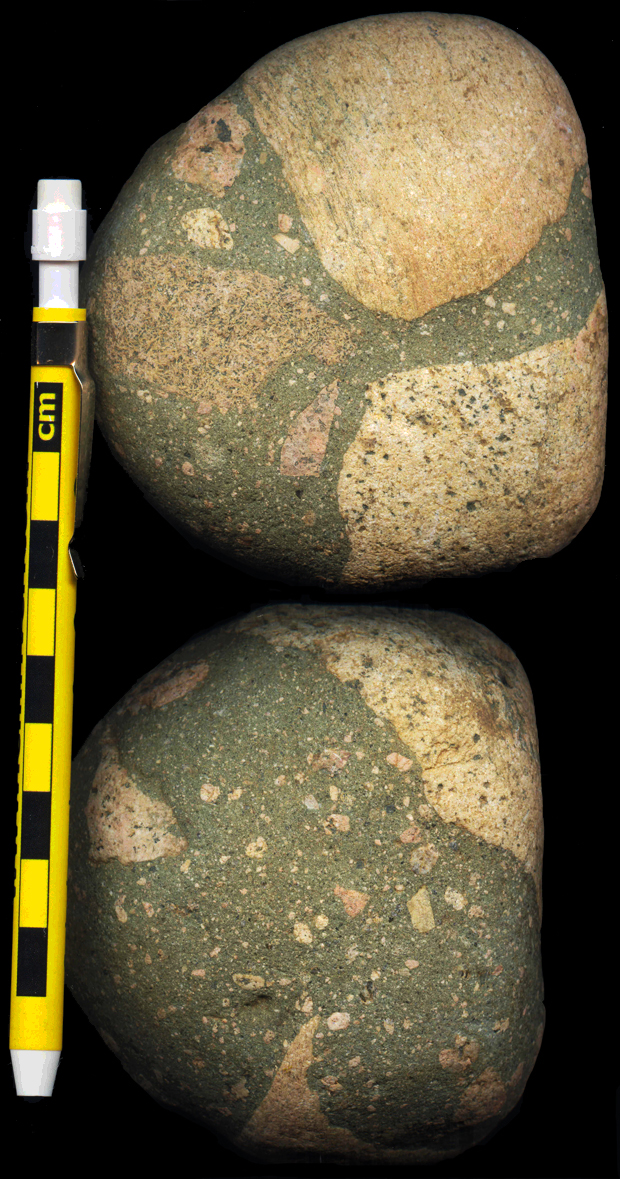Hoo boy. This one made me yelp…
While on the glacial geology of western Pennsylvania trip last Saturday, we visited a gravel quarrying operation. The operators were extracting gravel from a glacial lake delta deposit, and it was full of glacial outwash — sediments washed out from the melting front of the Erie lobe of the Laurentide ice sheet.
We were there to look at the Pleistocene features, but several of us twitched uncontrollably, to be so close to so many interesting looking cobbles, and we were soon rock-hounding it, checking out what the glaciers had brought to this location from so far away. We found mylonites and diabases, and sandstones, and limestones, granites and gneisses, most bearing distinctive glacial scratches and facets.
But this one… this one took the cake:

Yes, that’s one rock: The image gives you two views. I scanned the front and back, and used Photoshop to turn the two scans into a single image (with, of course, my awesome LRRD scale pencil for scale). A much bigger version is here.
With its poor sorting, dark matrix, and mix of rounded and angular clasts (many of distinctive pink granite), that looks to me like the Gowganda Tillite, a Paleoproterozoic “Snowball Earth” deposit from central Ontario.My student Robin picked it up on the field trip, right next to the feet of my student Troy! (Troy is pissed that he didn’t spot it first, let me tell you!)
Get what’s so cool about it? This rock is made of sediment that was deposited by a glacier in central Ontario ~2.5 billion years ago. Then that till (poorly sorted glacial sediment) was lithified into tillite, and then well nigh on 2.5 billion years later, a piece of it got plucked off by a Pleistocene glacier, and the cobble was carried south, across what would eventually be declared the U.S. border. It melted out of the ice in western Pennsylvania. A stream carried it into a lake at the margin of the glacier, where it was deposited amid an assortment of sediment that strongly resembled its own internal texture. There it remained, buried until unearthed by the excavations of the gravel company. Then we came along, and Robin picked it up: it’s a twice-glaciated rock!
Technically, the Pleistocene glacial deposit was outwash, rather than moraine (“till”), so it’s not a perfect match for the same depositional process acting at two times. But it was deposited twice by glaciers, glaciers whose ages are separated by half the age of the Earth. Neat, eh?

Troy, please consider this my public apology for yoinking that rock out from between your feet. I am most heartily sorry, even though it’s your own fault for not looking down in a place like that as a sensible person should. ;o)
Very cool! It reminds me of some of the nearby conglomerates when I tell students that the cobbles came from 2 mountain ranges ago. But you win with the overall time span.
Yesterday I called the LRRD to order 20 of the above pictured pencils for a group of Cub Scouts that are working on their Geology merit badge in Reston, Virginia. I was going to buy the pencils for the kids. Just this afternoon LRRD called me back to let me know they are donating the pencils to the scout troop. I wanted to thank LRRD for this kind donation, plus thank Callan for providing a link to this really cool product.
Awesome — Steve is a lousy businessman for giving his products away, but an awesome person! He gave me a 100 or so.
It is neat. We have a 20,000 pound tillite on our property (moved here by man, although from a location not too far away), and I am in the process of trying to come up with an interpretive sign for you. Reading this post helped! Most of the info I’ve found has been written by geologists for geologists – not easily read (or comprehended) by the greater unwashed public! Thanks!
Cool! Post a link to the sign if you can!
When we finally get it finished, I will gladly do so!
Wow, that really looks like the Mt. Rogers tillite, for comparison. I was going to play skeptic and wonder about possible “Catskill” debris flow rocks, but I think that would be a waste of time (I recall seeing debris flow rocks in the basal “Potsdam” but the clasts there were all local lowland Adirondack metamorphics). That is an incredible find – worth a “rock of the week” prize.
Oh, and check out that clast on the left,upper photo. Are those staurolite pseudomorphs?
I have 3 that came to Cheboygan, Michigan many years ago illegally across the border at night. LOL
Statute of limitations – these existed long before the border, or laws thereabout.
Interested in more. I live on Lake Huron just north of Alpena. There are a lot of these on beaches around my house.